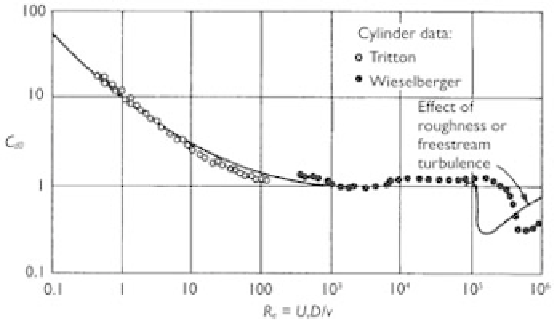Geoscience Reference
In-Depth Information
Figure 10.6
Drag coefficient for single cylinder (White, 1991).
Li and Shen (1973) investigated the drag coefficient for a group of cylinders with
various setups. They identified four factors that need to be considered to determine the
drag coefficient: (1) flow turbulence, (2) non-uniform velocity profile, (3) free surface,
and (4) blockage. Lindner (1982) suggested that in densely vegetated channels, the first
two of these factors are of minor importance and can be neglected. Lindner extended
the work of Li and Shen, and established the following formula to compute the drag
coefficient
C
d
for a single cylinder in a group:
l
n
C
d
0
0.2025
l
s
C
d
0
1
0.46
2
l
n
l
n
2
1.9
D
C
d
=
+
+
D
−
(10.10)
D
−
The two terms on the right-hand side of Eq. (10.10) represent the blockage and free
surface effects, respectively. The experiments were conducted with PVC cylinders of
10 mm in diameter and 150 mm in height.
Based on Lindner's approach and further experiments, Pasche and Rouve (1985)
presented a semi-empirical iterative process to determine
C
d
. Many other investigators,
e.g., Klaassen and Zwaard (1974) and Jarvela (2002), suggested the drag coefficient
C
d
would have values close to 1.5 for most practical cases.
The drag coefficient
C
d
in Eq. (10.7) is based on the apparent velocity
U
v
. According
to Stone and Shen (2002), the drag coefficient
C
dm
based on the constricted cross-
sectional velocity
U
vm
shown in Fig. 10.7 is more appropriate than
C
d
. This is because
C
dm
is closer to the drag coefficient of single cylinder and has less variation for a wide
range of values for vegetation density, stem size, and cylinder Reynolds number in
comparison with
C
d
. The relation between
C
d
and
C
dm
is
U
vm
U
v
C
d
=
C
dm
(10.11)

